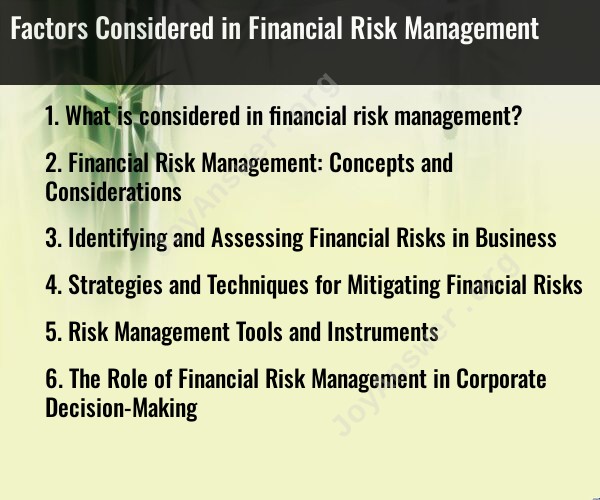What is considered in financial risk management?
Financial risk management is a critical practice for individuals, businesses, and financial institutions to identify, assess, and mitigate potential risks that could impact their financial well-being. Several factors and considerations are important in the process of financial risk management:
Risk Identification:
- The first step is to identify various types of financial risks, including market risk, credit risk, operational risk, liquidity risk, and legal/regulatory risk. Understanding the specific risks relevant to your situation is crucial.
Risk Assessment:
- Once risks are identified, they need to be assessed in terms of their potential impact and likelihood. This involves quantifying risks to determine their severity and probability.
Risk Tolerance and Objectives:
- Determine your risk tolerance, which is the level of risk you are willing and able to bear. This should align with your financial objectives and goals, which might include wealth preservation, income generation, or growth.
Diversification:
- Diversification involves spreading investments or exposures across various asset classes, geographic regions, or industries to reduce risk. It's a common strategy for managing investment risk.
Hedging Strategies:
- Employ hedging strategies, such as options, futures contracts, and derivatives, to offset or mitigate specific risks. For example, using derivatives can help hedge against adverse price movements in financial markets.
Insurance:
- Purchase insurance policies to protect against various risks. This can include health insurance, life insurance, property and casualty insurance, and other forms of coverage.
Emergency Funds:
- Maintain an emergency fund or cash reserve to cover unexpected expenses or emergencies, reducing the impact of liquidity risk.
Budgeting and Financial Planning:
- Develop a comprehensive financial plan and budget to manage cash flows, monitor expenses, and ensure you are prepared for financial obligations.
Stress Testing and Scenario Analysis:
- Conduct stress tests and scenario analyses to evaluate how your financial situation would be affected under different adverse conditions, helping to anticipate potential risks.
Regulatory Compliance:
- Ensure compliance with financial regulations and laws that apply to your specific situation, as non-compliance can result in legal and financial risks.
Due Diligence:
- Before making financial decisions, conduct thorough due diligence and research to understand the risks and rewards associated with investments, loans, or other financial transactions.
Constant Monitoring and Review:
- Regularly monitor your financial situation, market conditions, and the performance of your investments. Be prepared to adjust your risk management strategies as circumstances change.
Professional Advice:
- Seek advice from financial professionals, such as financial advisors, accountants, and lawyers, who can provide guidance on risk management strategies.
Comprehensive Risk Management Plan:
- Develop a comprehensive risk management plan that outlines your risk management strategies, objectives, and processes.
Effective financial risk management is an ongoing process that requires diligence, adaptability, and a clear understanding of your financial situation and goals. By addressing these factors, individuals and organizations can make informed decisions to protect their financial well-being and achieve their financial objectives.
Financial Risk Management: Concepts and Considerations
Financial risk management is the process of identifying, assessing, and mitigating the financial risks faced by a business or individual. It involves developing and implementing strategies to reduce the likelihood and impact of adverse financial events.
Financial risks can arise from a variety of sources, including:
- Market risk: The risk of losses due to changes in interest rates, exchange rates, or commodity prices.
- Credit risk: The risk of losses due to the default of a borrower or counterparty.
- Operational risk: The risk of losses due to failures in internal processes, people, or systems.
- Liquidity risk: The risk of being unable to meet financial obligations when they are due.
Financial risk management is important for all businesses and individuals, but it is especially important for those with complex financial operations or who are exposed to a high degree of risk.
Identifying and Assessing Financial Risks in Business
The first step in financial risk management is to identify all of the financial risks faced by the business. This can be done by conducting a risk assessment, which involves evaluating the following factors:
- The nature of the business and its activities
- The industry in which the business operates
- The regulatory environment in which the business operates
- The business's financial position and risk tolerance
Once the risks have been identified, they must be assessed to determine their likelihood and impact. This can be done using a variety of quantitative and qualitative techniques.
Strategies and Techniques for Mitigating Financial Risks
Once the risks have been identified and assessed, the business can develop and implement strategies to mitigate the risks. Some common risk mitigation strategies include:
- Diversification: Spreading investments across a variety of asset classes and industries to reduce the risk of losses in any one area.
- Hedging: Using financial instruments to offset the risk of adverse price movements in underlying assets.
- Insurance: Transferring the risk of losses to an insurance company for a premium.
- Internal controls: Implementing policies and procedures to reduce the risk of operational failures.
Risk Management Tools and Instruments
There are a variety of risk management tools and instruments that can be used to mitigate financial risks. Some common examples include:
- Derivatives: Financial instruments that derive their value from the underlying value of another asset. Derivatives can be used to hedge against price movements in underlying assets.
- Insurance: Contracts that transfer the risk of losses to an insurance company for a premium.
- Credit default swaps: Contracts that protect against the default of a borrower or counterparty.
- Catastrophe bonds: Bonds that provide investors with a return if a specific catastrophe does not occur.
The Role of Financial Risk Management in Corporate Decision-Making
Financial risk management plays an important role in corporate decision-making. By identifying, assessing, and mitigating financial risks, businesses can make informed decisions that reduce the likelihood of losses and improve their financial performance.
For example, a business may decide to diversify its product offerings to reduce its reliance on any one product or market. Or, a business may decide to hedge against currency fluctuations to protect its bottom line.
By effectively managing financial risks, businesses can improve their chances of success in the long term.











